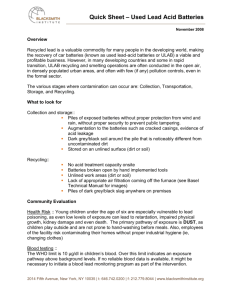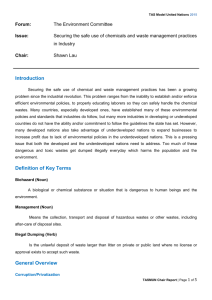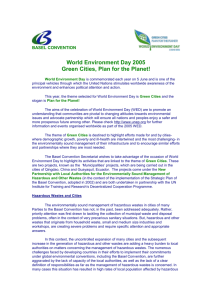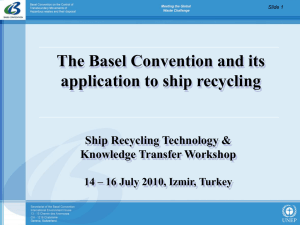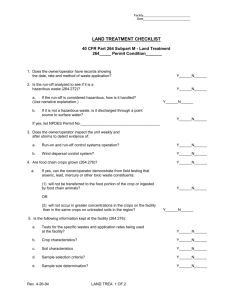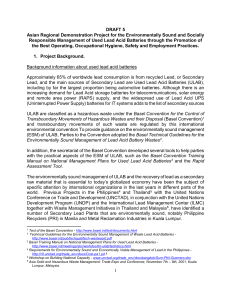Room Document - World Health Organization
advertisement
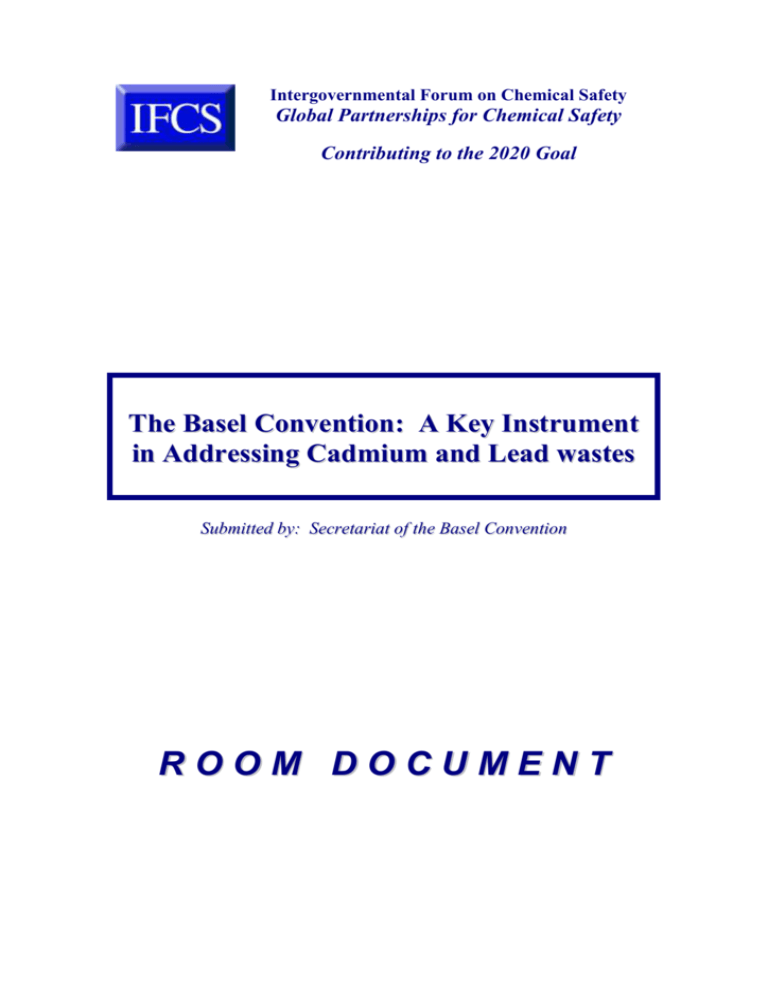
Intergovernmental Forum on Chemical Safety Global Partnerships for Chemical Safety Contributing to the 2020 Goal The Basel Convention: A Key Instrument in Addressing Cadmium and Lead wastes Submitted by: Secretariat of the Basel Convention ROOM DOCUMENT The Basel Convention: A Key Instrument in Addressing Cadmium and Lead wastes Submitted by the Secretariat of the Basel Convention Executive Summary The purpose of this information paper is to highlight the relevancy and importance of the Basel Convention in the area of cadmium and lead and aims at assisting the Sixth Session of the Intergovernmental Forum on Chemical safety (IFCS Forum VI) in their deliberations of the topic on International Transport of Lead and Cadmium via Trade: an International Concern? The environmentally sound management (ESM) of hazardous waste constitutes a fundamental objective of the Basel Convention under which Parties are required to take a set of measures to ensure that hazardous wastes are managed in an environmentally sound manner. This obligation constitutes a solid basis for the development more stringent obligations - such as progressive phase out and prohibitions on the use of heavy metals such as lead and cadmium, if such measures are called for. For several years, the Basel Convention was already involved in regional projects on used lead acid batteries. Initiatives which are aiming to promote the sustainable use of materials such as the Basel Convention led pilot projects on e-wastes in Asia Pacific, the Mobile Phone Partnership Initiative (MPPI) and the newly established Partnership for Action on Computer Equipment (PACE) and the Green Lead Initiative are also producing tangible results. These initiative and programmes not only ensure compliance to the Convention requirements but also promote resource recovery as well as the utilization of secondary materials through environmentally sound recovery and recycling. The Basel Convention is possibly the most relevant existing global instrument to deal with lead and cadmium-related issues and should be considered a key contributor to any international efforts to address these heavy metals, whether these efforts are of a voluntary nature or are to be carried out under a legally binding instrument. I. Key objectives of the Basel Convention 1. The Basel Convention on the Control of Transboundary Movements of Hazardous Wastes and Their Disposal was adopted in May 1989 and came into force in May 1992. The main goal of the Convention is to protect human health and the environment against the adverse effects which may result from the generation, transboundary movements and management of hazardous wastes and other wastes. To achieve this goal a number of interrelated objectives have to be fulfilled: reducing the transboundary movements of hazardous wastes; minimizing the quantity and hazardousness of wastes generated and ensuring their environmentally sound management; and assisting developing countries in environmentally sound management of the hazardous wastes. As of August 2008, a total of 170 States and an economic integration organization are Parties to the Convention. 2. Since its inception, the Basel Convention has established systems to regulate and restrict the export and import of hazardous wastes and other wastes through the notification and prior informed consent procedures. In addition, the Convention does not permit the exports or imports of hazardous wastes or other wastes between a state Party and a non-Party, provided the countries involved have concluded a bilateral or regional agreement pursuant to Article 11 of the Convention. For the export of hazardous wastes from OECD to non-OECD countries, in 1995 the Basel Convention adopted a decision to amend the Convention that when fully enforced would ban the export of hazardous wastes from Annex VII (OECD, EC and Liechtenstein) to non-Annex VII countries. Although the Ban Amendment is not yet enforced due to lack of ratification, it has been implemented by many countries such as those Parties that are members of the European Community. 3. A central goal of the Basel Convention is “environmentally sound management (ESM)”, the aim of which is to protect human health and the environment from the adverse effects which may result from hazardous and other wastes. ESM means addressing the issue through an “integrated lifecycle approach”, which involves strict controls from the generation of a hazardous waste to its storage, transport, treatment, reuse, recycling, recovery and final disposal. Towards this end, in 1999 Parties to the Convention adopted the Basel Declaration on environmentally sound management which within the framework of integrated life-cycle management of materials, the following fundamental objectives are to be pursued: (a) To prevent to the extent possible and minimize the generation of hazardous and other wastes; (b) To treat and dispose of such wastes in such a way that they do not cause harm to health and the environment; (c) To eliminate or reduce transboundary movements of hazardous and other wastes. 4. The seventh meeting of the Conference of the Parties to the Basel Convention identified used lead acid batteries as one of its Strategic Plan focus areas. The Governing Council of the United Nations Environment Programme (UNEP GC) has adopted a number of decisions relevant to lead and cadmium, in particular decisions 21/6 (lead in gasoline); 22/4 (chemicals); 23/9 III (chemicals management) which called for the reviews of scientific information on lead and cadmium; and 24/3 III (chemicals management). The Intergovernmental Forum on Chemical Safety at its fifth session held in Budapest, Hungary, from 25 to 29 September 2006 issued the Budapest Statement on Mercury, Lead and Cadmium. II. Classification of cadmium and lead wastes under the Basel Convention 5. Since cadmium and lead are heavy metals, these elements and their wastes are covered under the Basel Convention (see annex). 6. The following hazardous characteristics in Annex III of the Basel Convention are relevant for cadmium and lead: (a) Poisonous (Acute) (United Nations (UN) Class: 6.1; Code: H6.1): Substances or wastes liable either to cause death or serious injury or to harm human health if swallowed or inhaled or by skin contact; (b) Toxic (Delayed or chronic) (UN Class: 9; Code H11): Substances or wastes which, if they are inhaled or ingested or if they penetrate the skin, may involve delayed or chronic effects, including carcinogenicity. 7. Because of bioaccumulation and biomagnification if wastes are released into the environment, the following hazardous characteristic are also relevant: (a) Ecotoxic (H12) - Substances or wastes which if related present or may present immediate or delayed adverse impacts to the environment by means of bioaccumulation and/or toxic effects upon biotic systems; (b) H13 - Capable, by any means, after disposal, of yielding another material, e.g., leachate, which possesses any of the characteristics listed. III. Involvements of the Basel Convention in the environmentally sound management of lead and cadmium wastes 8. The general obligations of the Parties to the Basel Convention are to ensure the reduction of the generation of hazardous and other wastes, the availability of adequate treatment, recovery, recycling and disposal facilities for hazardous wastes, the minimization of the harmful consequences of pollution to human health and the environment, and the reduction of transboundary movements of such wastes, all of which necessitate an integrated approach to chemical and waste management. The environmentally sound management approach calls for up-stream preventive measures by encouraging waste minimization, minimization of residues at source, recycling, and looking for alternatives. In this connection, the Convention has been involved in various capacity building projects and activities pertaining to the environmentally sound management of lead and cadmium wastes. The contribution of the Convention, as can be seen in the following paragraphs, includes providing the much needed technical guidance and tools on how these hazardous wastes should be managed as well as through concrete activities with countries. A. Used lead acid batteries (ULAB) 9. Recycling of used lead acid batteries (ULAB) is a common measure in countries in order to benefit from recovery of lead and reducing the amount of lead releases to the environment. In many developed and developing countries, the rate of collection of ULAB is generally high and well-organized. Under the Basel Convention, the following technical guidelines and manuals were developed and published to assist Parties and other stakeholders in this respect:1 (a) Technical Guidelines for the Environmentally Sound Management of Waste Lead Acid Batteries (2002); (b) Training Manual for the Preparation of National Used Lead Acid Batteries Environmentally Sound Management Plans in the Context of the Implementation of the Basel Convention (2004) 10. The technical assistance and capacity building programme of the Basel Convention for the environmentally sound management of ULAB was initiated in 2001 in the wider Caribbean region in the context of the implementation of the Ministerial Declaration on ESM. A project was launched in 2001 which aimed at assessing the situation concerning the ESM of ULAB in nine countries in the Caribbean region. This project culminated with the convening of a regional workshop in November 2002 (San Salvador) which made a number of concrete recommendations, including the development of a regional strategy for the ESM of ULAB in the Caribbean 1 http://www.basel.int/meetings/sbc/workdoc/techdocs.html region. The regional strategy has been further developed through an enlarged consultation process involving governments, academia, industry and the civil society. 11. This preliminary work has helped in defining in detail the scope and seriousness of the problems that are associated with lead exposure in the ULAB recycling sector, in particular in the informal sector in developing countries. In addition, it has identified ways forward to improve collaboration to achieve ESM and has helped review the legal, technical and economic aspects of a regionally integrated approach for the ESM of ULAB that should serve all countries in the wider Caribbean but could be replicated in other regions as well. In this regard, it is worth noting that a similar approach could already be initiated in South-East Asia where a pilot country project on the ESM of ULAB has already been carried out. 12. To date, the completion of the above mentioned activities has contributed to develop a long-term strategic alliance with the lead smelting industry which was known to be opposing the objectives of the Basel convention at the time of the start of activities and the negotiations of the Technical Guidelines. Since its inception, the programme has pursued the following objectives in a progressive but systematic way: (a) Assistance to countries in implementing the objectives, principles and standards for ESM set forth in the Basel Convention Technical Guidelines (TGs) on the ESM of ULAB (2002); (b) Development of decision supportive tools and training material of quality on the ESM of ULAB and building of a Basel Convention savoir faire at the SBC level and the BCRCs level; (c) Undertaking of national and regional field activities through a partnership approach with a wide array of partners, including specialized agencies, academia, industry and NGOs; (d) Development of regional strategies in partnerships with all key stakeholders. B. The Green Lead initiative 13. At the same time, SBC has been participating in the Green Lead Initiative. The Green Lead Initiative is an international effort aimed at putting in place a global standard and audit system for a third party certification of companies in the lead-acid battery lifecycle in order to provide assurances that the production, use and recycling of lead in batteries could be achieved under conditions that ensure the highest levels of safety to people and the environment. The proposed standard and audit system would be supportive of the concept of the environmentally sound management of used lead acid batteries as defined by the Basel Convention. Details of the concept are to found at www.greenlead.com.. The development of a universal ‘standard’ based on such principles as ESM and extended producer responsibility (product chain partnership) would be fully supportive of the Basel Convention activities on the ESM of ULAB. In this regard, SBC’s participation in the Green Lead initiative has resulted in transforming an industry led initiative into a multi-stakeholders partnership involving, in particular, governments from developing countries, NGOs and specialized agencies. C. Preliminary elements of a four-year capacity building and technical assistance programme on the ESM of lead waste 14. The goal for this second phase of the capacity building and technical assistance programme on the ESM of ULAB will be to assist Parties in implementing the provisions of the Basel Convention and the principles of ESM as they are set in the relevant Basel Convention Technical Guidelines. The programme will be pursuing the following specific objectives: (a) Building on the achievements of the initial phase, implementation of the Caribbean project (Phase III) and replication to other requesting regions of the methodology and process developed in the Caribbean region; (b) Further development of the Basel Convention set of decisionmaking, awareness raising and training tools; (c) Development of a strategic alliance for the setting up of regional certification schemes on the ESM of used lead acid batteries; (d) Development of a strategic partnership with ILO on the ESM of ULAB and workers‘ protection in the informal lead recycling sector. 15. In line with the above stated objectives, the following programme components and activities are being proposed: (a) Development of the Basel Convention set of decision-making, awareness raising and training tools: (i) Review/(update) of ESM practices and technologies for lead recycling; (ii) Guidance/training manual on workers’ protection in the lead recycling informal sector; (iii) Development/endorsement of a set of protocols that are critical for putting in place a certification scheme on the ESM of ULAB, such as site sustainability, public communications and awareness, ULAB labels, collection schemes, and biological monitoring and medical surveillance; (b) Replication of the Caribbean Basel Convention ULAB experience in other regions: (i) Implementation of the Caribbean strategy for the ESM of ULAB (Phase III) (2008-2011); (ii) Regional project for the ESM of ULAB in the Mediterranean region with key stakeholders; (iii) Development of a country project on the ESM of ULAB in Egypt (2008-2009); (iv) In consultation with the UNEP/MAP office, development of a regional approach for the ESM of ULAB in Arab States (2009-2011); (v) Regional project for the ESM of ULAB in ASEAN countries with key stakeholders (US$2 million-first phase, draft proposal available upon request); (vi) National ULAB ESM assessment in ASEAN countries (2008-2009); (vii) Preparation of national ULAB ESM plans in ASEAN countries (2010); (ix) Development of a regional strategy for the ESM of ULAB in ASEAN region, including the setting up of a certification scheme for the ESM of ULAB (2010-2011); (c) Strategic alliance with the Green-Lead Initiative on the development and testing of a ULAB ESM certification scheme in one region: (i) Participation in the activities of the Green-Lead, and development of the Green-Lead Protocols in line with the obligations, principles and standards of the Basel Convention; (ii) Integration of the Green-Lead certification scheme as a fundamental element of the regional strategy on the ESM of ULAB in the Caribbean region, and pilot testing of the certification scheme. D. Regional Strategy for the Environmentally Sound Management of Used Lead Acid Batteries in Central America, Colombia, Venezuela and the Caribbean region 16. In the context of a multi-partner international initiative in the context of the Basel Convention, governments, the lead recycling industry, academia and non-governmental organizations have prepared a regional strategy for the design and implementation of a mechanism for the environmentally sound management (ESM) of used lead acid batteries (ULAB) in Central America, Colombia, Venezuela and the Caribbean Island States. The regional strategy is based on the following concepts and principles: (a) The concept of ESM of used lead acid batteries as defined in the context of the Basel Convention; (b) Regional integration and coordination of the national policies for the ESM of ULAB; (c) Reliance on and upgrade to appropriate ESM standards of existing facilities in the region for lead recycling; (d) Facilitation, as per necessary, of the movements of ULAB in the sub-region in accordance with the provisions of the Basel Convention; (e) Setting up of a regional certification system for the ESM of ULAB in close collaboration with industry. 17. The strategy touches upon the environmental, health, transport and trade aspects of the ESM of used lead acid batteries in the wider Caribbean region. An important component of the strategy implies the involvement of the civil society led by NGOs, as well investments in ESM facilities from industry. 18. The regional strategy builds on the outcome of the ‘Pilot Project for the Environmentally Sound Management of Used Lead Acid Batteries under the Basel Convention’ implemented in eight countries (Colombia, Dominican Republic, El Salvador, Mexico, Panama, St Lucia, Trinidad & Tobago, Venezuela) in Central America and the Caribbean region, and on the regional consolidation effort that was carried out soon afterwards. Because of the economic interdependence of the countries in the region, the setting up of a regional environmentally sound management scheme for ULAB was considered to be feasible only through the coordination of national lead recycling policies taking into consideration the likely variations between them. Several documents have been prepared in the context of the preparatory phases, including a training manual on the preparation of national plans for the environmentally sound management of used lead acid batteries which may well be considered an international milestone in this field. The regional strategy will be implemented over a four year period. E. Capacity building and emergency assistance 19. On 15 April 2008, the Ministry of the Environment and Natural Resources in Senegal made an official request for technical assistance to the Secretariat of the Basel Convention concerning a case of contamination of local populations, mainly women and children, from hazardous waste due to lead recovery activities in the informal sector from used lead acid batteries. Assistance was requested with a view to reviewing the situation at Thiaroye sur Mer and ascertaining what actions needed to be considered locally and nationally, in the short-term and the longer term, to prevent further contamination from lead of local populations and assist in developing a national plan for the environmentally sound management of used lead acid batteries in the context of the implementation of the Basel Convention. The mission was prepared further to consultations with the WHO Headquarters in Geneva and the UNEP-OCHA office in Geneva. F. Cadmium waste 20. Technical guidelines developed under the Basel Convention that may be relevant for cadmium include:2 (a) Technical guidelines on the environmentally sound recycling/reclamation of metals and metal compounds (R4) (2004); (b) Basel Convention Technical Guidelines on Hazardous Waste Physico-Chemical Treatment (D9)/ Biological Treatment (D8) (2000). G. Electrical and electronic waste (e-waste) 21. A newly emerging waste problem that is facing the world in recent years is the increasing generation of electrical and electronic waste (e-waste). Under the Basel Convention, electrical and electronic wastes are characterized 2 see footnote 1 as hazardous wastes under the Convention when they contain components such as accumulators and other batteries, mercury switches, glass from cathode-ray tubes and other activated glass, PCB-containing capacitors or when contaminated with cadmium, mercury, lead or PCBs. Also, preciousmetal ash from the incineration of printed circuit boards, LCD panels and glass waste from cathode-ray tubes and other activated glasses are characterized as hazardous wastes. To address the environmental issues related to the increasing transboundary movements of these wastes, and to ensure that their storage, transport, treatment, reuse, recycling, recovery and disposal is conducted in an environmentally sound manner, a proactive approach is essential. 22. Owing to the importance of this problem, the theme for the eighth meeting of the Conference of the Parties to the Basel Convention, held in Nairobi from 27 November to 1 December 2006, was “Creating Innovative Solutions through the Basel Convention for the Environmentally Sound Management of Electronic Waste”. The high-level segment featured an indepth discussion on the theme during a one-day World Forum on E-wastes. Ministers, corporate officials, civil-society representatives and other participants explored solutions for advancing the objectives of ensuring the environmentally sound management of e-waste. Subsequently, the Nairobi Declaration on the Environmentally Sound Management of Electrical and Electronic Waste and decision VIII/2 were adopted by the Conference of the Parties at its eighth meeting (see UNEP/CHW.8/16*). The Nairobi Declaration forms the basis for further global actions to tackle e-waste problems under the Convention in the coming years. 23. Since 2002, various initiatives were implemented under the auspices of the Basel Convention regarding e-wastes which include the following: (a) The Mobile Phone Partnership Initiative was launched in 2002, during the sixth meeting of the Conference of the Parties to the Basel Convention; (b) The Basel Convention Partnership on the Environmentally Sound Management of Electrical and Electronic Wastes for the Asia-Pacific Region which was officially launched in Tokyo on 25 November 2005. The following Asian countries have supported and are participating in the project activities: Cambodia, China, India, Indonesia, Malaysia, the Philippines, Singapore, Sri Lanka, Thailand and Viet Nam; (c) The project on the Inventory of Electronic Wastes in the South American Region (2006); (d) A three-year programme of activities aimed at reviewing the range of issues currently facing African countries relating to the environmentally sound management of e-waste will be on stream in 2008. 24. At the ninth meeting of the Conference of the Parties (COP9) in June 2008, a work plan on e-waste under the Basel Convention was adopted. Under the Work Plan, the development of technical guidelines on e-waste will be carried out and a new Partnership for Action on Computer Equipment (PACE) will be launched. IV. Control of the transboundary movements3 25. The Basel Convention stipulates that any transboundary movement of wastes (export, import, or transit) is permitted only when the movement itself and the disposal of the concerned hazardous or other wastes are environmentally sound. 26. Article 4, paragraphs 2 (a)–(d), contain key provisions of the Basel Convention pertaining to ESM, waste minimization, and waste disposal practices that mitigate adverse effects on human health and the environment: “Each Party shall take appropriate measures to: (a) Ensure that the generation of hazardous wastes and other wastes within it is reduced to a minimum, taking into account social, technological and economic aspects; (b) Ensure the availability of adequate disposal facilities, for the environmentally sound management of hazardous wastes and other wastes, that shall be located, to the extent possible, within it, whatever the place of their disposal; (c) Ensure that persons involved in the management of hazardous wastes or other wastes within it take such steps as are necessary to prevent pollution due to hazardous wastes and other wastes arising from such management and, if such pollution occurs, to minimize the consequences thereof for human health and the environment; (d) Ensure that the transboundary movement of hazardous wastes and other wastes is reduced to the minimum consistent with the environmentally sound and efficient management of such wastes, and is conducted in a manner which will protect human health and the environment against the adverse effects which may result from such movement”. 27. Parties to the Basel Conventions should examine national controls, standards and procedures to ensure that they are in compliance with the Convention and with their obligations under them, including those which pertain to ESM of wastes consisting of, containing or contaminated with lead and cadmium. V. Relevance of the Basel Convention in the discussion on lead and cadmium 28. As stated in section III above, the environmentally sound management (ESM) of hazardous waste constitutes a fundamental objective of the Basel Convention. Under the general obligations of the Convention, Parties shall take a set of measures to ensure that hazardous wastes are managed in an environmentally sound manner. This obligation applies not only to waste generated domestically but also from transboundary sources. The general 3 For more details please see: http://www.basel.int/pub/instruct.doc obligation for minimizing the generation of the waste, in particular through product substitution and minimization, constitute a solid basis for the development more stringent obligations such as progressive phase out and prohibitions on the use of these heavy metals, if such measures are called for. The Basel Convention is already involved in voluntary initiatives which are aiming to promote the sustainable use of materials such as the Basel Convention led Partnership for Action on Computer Equipment (PACE) and Mobile Phone Partnership Initiative (MPPI) and its participation in the Green Lead Initiative. These programmes indirectly promote resource recovery as well as the utilization of secondary materials through environmentally sound recovery and recycling. 29. The Basel Convention is possibly the most relevant existing global instrument to deal with lead and cadmium-related issues and should be considered a key contributor to any international efforts to address these heavy metals, whether these efforts are of a voluntary nature or are to be carried out under a legally binding instrument. In fact, the Convention currently regulates most of the aspects of lead and cadmium that have been identified by the international community for priority action. Further, with regard to addressing the capacity building needs of the developing countries and countries with economies in transition and with the view to conserving existing resources, existing facilities should be utilized, such as by employing some of or all of the Basel Convention Regional Centers4 in various parts of the world. 4 for more information: http://www.basel.int/pub/broch-bcrc-270508.pdf Annex Classification of cadmium and lead wastes under the Basel Convention Annex I Y17 Y18 Y26 Y31 Wastes resulting from surface treatment of metals and plastics Residues arising from industrial waste disposal operations Cadmium; cadmium compounds Lead; lead compounds ANNEX VIII LIST A (Wastes contained in this Annex are characterized as hazardous under Article 1, paragraph 1 (a), of this Convention, and their designation on this Annex does not preclude the use of Annex III to demonstrate that a waste is not hazardous). A1010 Metal wastes and waste consisting of alloys of any of the following: • • Cadmium Lead but excluding such wastes specifically listed on list B. A1020 Waste having as constituents or contaminants, excluding metal waste in massive form, any of the following: • • 5 Cadmium; cadmium compounds Lead; lead compounds A1110 Spent electrolytic solutions from copper electrorefining and electrowinning operations A1180 Waste electrical and electronic assemblies or scrap5 containing components such as accumulators and other batteries included on list A, mercury-switches, glass from cathode-ray tubes and other activated glass and PCB-capacitors, or contaminated with Annex I constituents (e.g., cadmium, mercury, lead, polychlorinated biphenyl) to an extent that they This entry does not include scrap assemblies from electric power generation. possess any of the characteristics contained in Annex III (note the related entry on list B B1110)6 A1050 A1160 A1170 Galvanic sludge Waste lead-acid batteries, whole or crushed Unsorted waste batteries excluding mixtures of only list B batteries. Waste batteries not specified on list B containing Annex I constituents to an extent to render them hazardous A4070 Waste from the production, formulation and use of inks, dyes, pigments, paints, lacquers, varnish excluding any such waste specified in list B ANNEX IX LIST B B1020 Clean, uncontaminated metal scrap, including alloys, in bulk finished form (sheet, plate, beams, rods, etc), of: • Cadmium scrap • Lead scrap (but excluding lead-acid batteries) B1050 Mixed non-ferrous metal, heavy fraction scrap, not containing Annex I materials in concentrations sufficient to exhibit Annex III characteristics7 B1110 Electrical and electronic assemblies: • Electronic assemblies consisting only of metals or alloys • Waste electrical and electronic assemblies or 8 scrap (including printed circuit boards) not containing components such as accumulators and other batteries included on list A, mercury-switches, glass from cathode-ray tubes and other activated glass and PCB-capacitors, or not contaminated with 6 PCBs are at a concentration level of 50 mg/kg or more. Note that even where low level contamination with Annex I materials initially exists, subsequent processes, including recycling processes, may result in separated fractions containing significantly enhanced concentrations of those Annex I materials. 8 This entry does not include scrap from electrical power generation. 7 Annex I constituents (e.g., cadmium, mercury, lead, polychlorinated biphenyl) or from which these have been removed, to an extent that they do not possess any of the characteristics contained in Annex III (note the related entry on list A A1180) • Electrical and electronic assemblies (including printed circuit boards, electronic components and wires) destined for direct reuse,9 and not for recycling or final disposal10 B1130 Cleaned spent precious-metal-bearing catalysts ____________________ 9 Reuse can include repair, refurbishment or upgrading, but not major reassembly In some countries these materials destined for direct re-use are not considered wastes. 10
